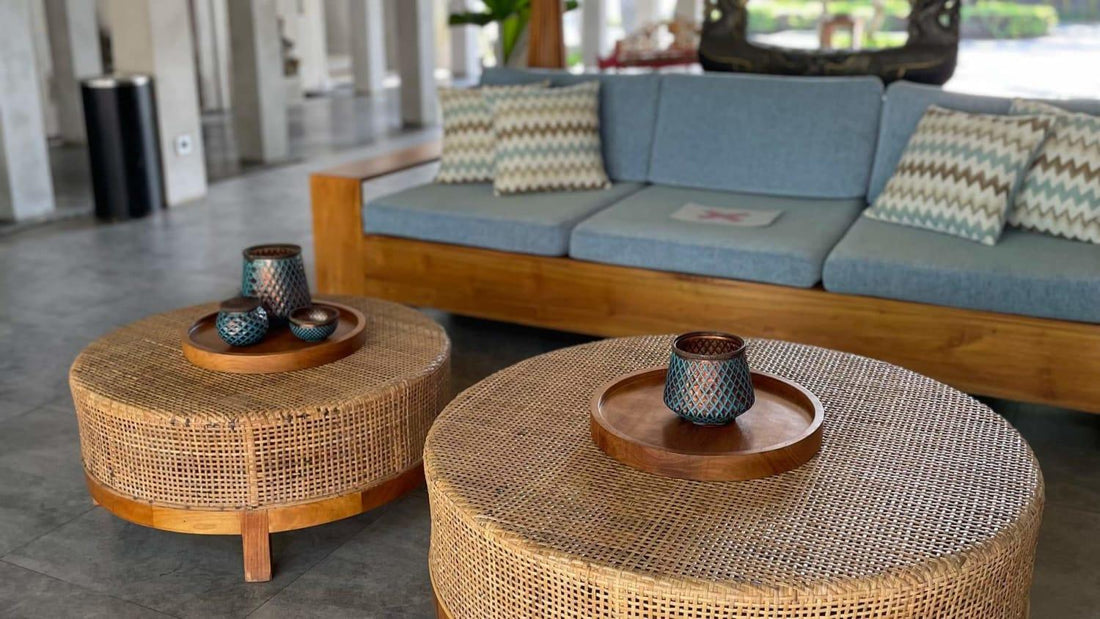Why Are Coffee Tables Important?
Although the topic appears to be amusing, coffee tables have evolved into an important part of your living space. A coffee table contributes to the ambiance of the room by being both utilitarian and decorative. It's a lovely centerpiece for your living area, where its simple yet significant presence brightens the space. It also integrates nicely with other sections of your living room, such as couches, carpets, paintings, and home decorative panels, when properly furnished. Most importantly, keep in mind that it has observed serious discussions, enjoyable get-togethers with friends, and even served as a footrest when watching your favorite show!
Set Of 2 Teak & Rattan Coffee Table, Satria
The history of coffee tables
It all began in the Victorian era in the 18th century. Tea was at the pinnacle of fashion at the time, in which everyone was drinking it from plastic cups. They were carrying their teacups around with them throughout their parties, which was inconvenient and spurred the demand for tea tables where they could put their cups.
Soon after, the tea-drinking vogue faded, but the tea-drinking trend endured. High-backed settees, which were fashionable in the second part of the seventeenth century in the U.K., were quickly supplanted by low-backed sofas. The coffee tables came into play (or into their living rooms, to be precise!) to complement these couches during their get-togethers. The Britons were allegedly the original designers of these low tables, and it was initially constructed out of wood.
Carved Coffee Table Hening in White Wash
Influences across cultures
Coffee tables, on the other hand, were a comparatively recent development. The Japanese floor-level tables, paired with Ottoman garden tables, are said to have influenced the early design of these tables. As a result, they differed from modern coffee tables, as the earlier ones were still lower in height. The designs altered over time, as materials became more readily available and the Industrial Revolution ushered in a new era of affordability. The British tried to customize coffee tables depending on each craftsman's style during the Arts and Crafts Movement, but industrialization remained, and the majority of the public favored affordability.
Then followed the Art Nouveau period, which gave birth to a variety of coffee table types. The Victorians loved intricate ornaments around the tables at the time of their creation, but this century avoided such forms. They were adamant about designing coffee tables with clean, basic lines and a strong emphasis on natural shapes. Artists were quickly affected by the combination of primitivism and modern technology (transportation modes such as planes and locomotives), resulting in geometric shapes and curves, as well as straighter lines, that were more attuned to the machine era. In terms of materials used, these artists began combining glass, steel, and acrylics into their work, resulting in more eclectically styled coffee tables.
Coffee tables have a lengthy history, which has given us the variety of possibilities we have today! You may now get rounded coffee tables made of wood that represent naturalism and modernism, as well as a variety of fashions that reflect historical periods. It has shown us enough that when it comes to cultures, coffee tables have become a part of globalization as well. You can even buy an Ottoman table built in Turkey, or a coffee table with Balinese hand carvings, like the one shown below! Really, when it comes to design, there are no boundaries!
Reclaimed Teak Coffee Table, Suku
How to choose coffee tables
A coffee table, as previously stated, is an important aspect of the aesthetic and functioning of your living area. It can be a space where you can play video games, have snacks on movie nights, or even have your kids do their homework. Before you go out and get the best one for your family, think about three things: location, size, and how your layout design will be affected.
Consider where you are going to put your coffee table. What will it be used for? It's worth noting that glass ones are more prone to breakage or scratching, especially if you have youngsters. The ones made of wood or steel are more resistant to a variety of conditions.
Second, what is the optimal size and shape in this situation? Is it going to be square, rectangular, or rounded? A square couch will fit well before a sectional couch. If you prefer a versatile coffee table, rectangle or oblong-shaped tables can work well with any couch shape. If you have active children, however, use the rounded ones to avoid sharp edges.
Carved Teak Coffee Table, Kelungkung
Finally, think about how your living room is laid out. Ensure that your choice will complement the aesthetic of your space, rather than being an out-of-place oddity.
What are your thoughts on coffee tables? Do you have any preferences that you'd want to share? Please share your thoughts in the comments box below!





